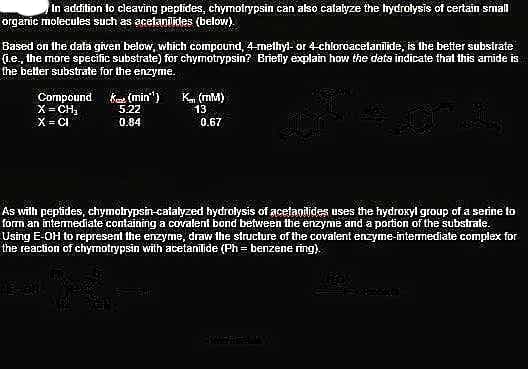In addition to cleaving peplides, chymotrypsin can akso catalyze the hydrołysis of certain small organic molecules such as acetanides (below). Based on the data given below, which compound, 4-melhyl- or 4-chloroacetanilide, is the better substrate (L.e., the more specific substrate) for chymotrypsin? Briefly explain how the data indicate that this amide is the better substrate for the enzyme. Cormpound X= CH, X= CI Kae (min") 5.22 K (mM) 13 0.84 0.67
In addition to cleaving peplides, chymotrypsin can akso catalyze the hydrołysis of certain small organic molecules such as acetanides (below). Based on the data given below, which compound, 4-melhyl- or 4-chloroacetanilide, is the better substrate (L.e., the more specific substrate) for chymotrypsin? Briefly explain how the data indicate that this amide is the better substrate for the enzyme. Cormpound X= CH, X= CI Kae (min") 5.22 K (mM) 13 0.84 0.67
Biochemistry
9th Edition
ISBN:9781319114671
Author:Lubert Stryer, Jeremy M. Berg, John L. Tymoczko, Gregory J. Gatto Jr.
Publisher:Lubert Stryer, Jeremy M. Berg, John L. Tymoczko, Gregory J. Gatto Jr.
Chapter1: Biochemistry: An Evolving Science
Section: Chapter Questions
Problem 1P
Related questions
Question
2

Transcribed Image Text:In addition to cleaving peplides, chymotrypsin can also catalyze the Irydrolysis of certain smal
organic molecules such as acetanīlides (below).
Based on the data given below, which compound, 4-melhyl- or 4-chloroacelanilide, is the better substrate
(L.e., the more specific substrate) for chymotrypsin? Briefly explain how the data indicate that this amide is
the better substrate for the enzyme.
Compound
X= CH,
Ka (min")
5.22
K. (mM)
13
X= CI
0.84
0.67
As wilh peptides, chymolrypsin-catalyzed hydrolysis of acetanilides uses the hydroxyl group of a serine to
form an intermediate containing a covalent bond between the enzyme and a portion of the substrate.
Using E-OH to represent the enzyme, draw the structure of the covalent enzyme-intermediate complex for
the reaction of chymotrypsin with acetanilide (Ph = benzene ring).
Expert Solution
This question has been solved!
Explore an expertly crafted, step-by-step solution for a thorough understanding of key concepts.
Step by step
Solved in 2 steps with 1 images

Recommended textbooks for you

Biochemistry
Biochemistry
ISBN:
9781319114671
Author:
Lubert Stryer, Jeremy M. Berg, John L. Tymoczko, Gregory J. Gatto Jr.
Publisher:
W. H. Freeman

Lehninger Principles of Biochemistry
Biochemistry
ISBN:
9781464126116
Author:
David L. Nelson, Michael M. Cox
Publisher:
W. H. Freeman

Fundamentals of Biochemistry: Life at the Molecul…
Biochemistry
ISBN:
9781118918401
Author:
Donald Voet, Judith G. Voet, Charlotte W. Pratt
Publisher:
WILEY

Biochemistry
Biochemistry
ISBN:
9781319114671
Author:
Lubert Stryer, Jeremy M. Berg, John L. Tymoczko, Gregory J. Gatto Jr.
Publisher:
W. H. Freeman

Lehninger Principles of Biochemistry
Biochemistry
ISBN:
9781464126116
Author:
David L. Nelson, Michael M. Cox
Publisher:
W. H. Freeman

Fundamentals of Biochemistry: Life at the Molecul…
Biochemistry
ISBN:
9781118918401
Author:
Donald Voet, Judith G. Voet, Charlotte W. Pratt
Publisher:
WILEY

Biochemistry
Biochemistry
ISBN:
9781305961135
Author:
Mary K. Campbell, Shawn O. Farrell, Owen M. McDougal
Publisher:
Cengage Learning

Biochemistry
Biochemistry
ISBN:
9781305577206
Author:
Reginald H. Garrett, Charles M. Grisham
Publisher:
Cengage Learning

Fundamentals of General, Organic, and Biological …
Biochemistry
ISBN:
9780134015187
Author:
John E. McMurry, David S. Ballantine, Carl A. Hoeger, Virginia E. Peterson
Publisher:
PEARSON